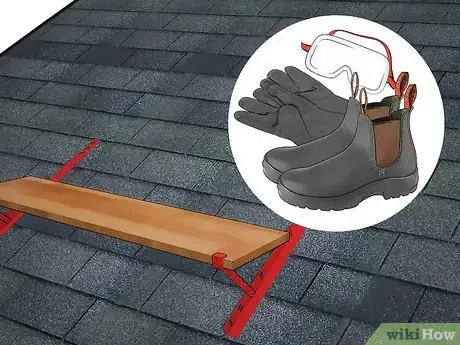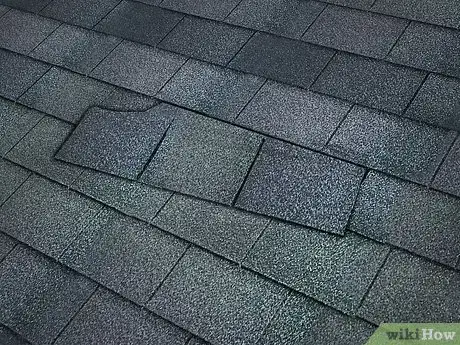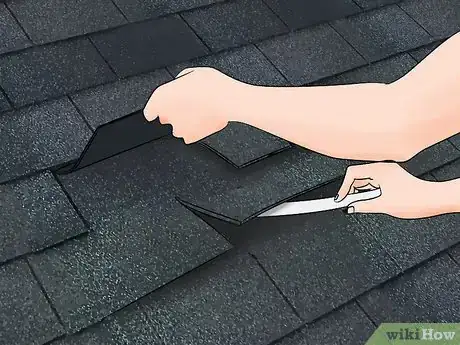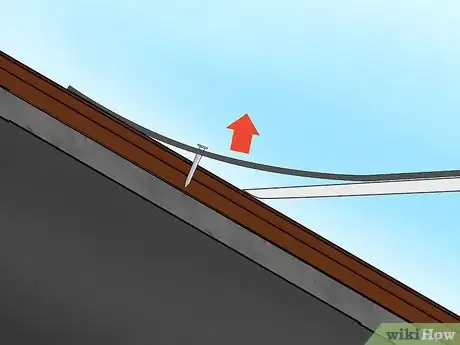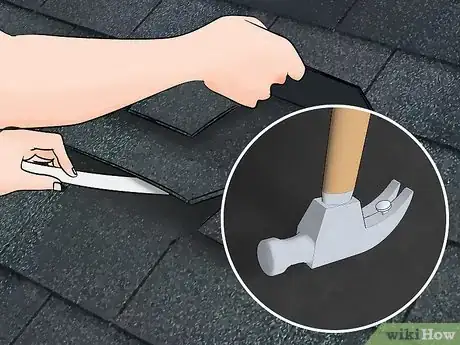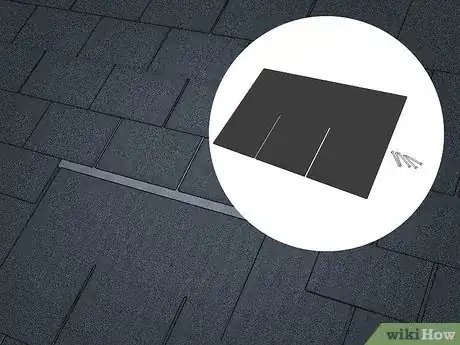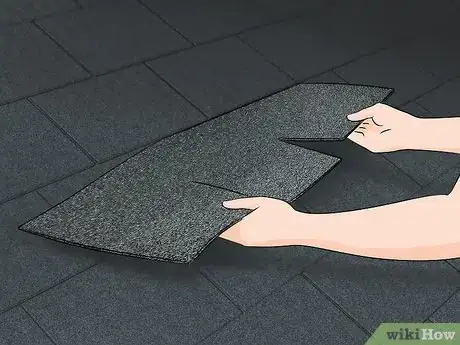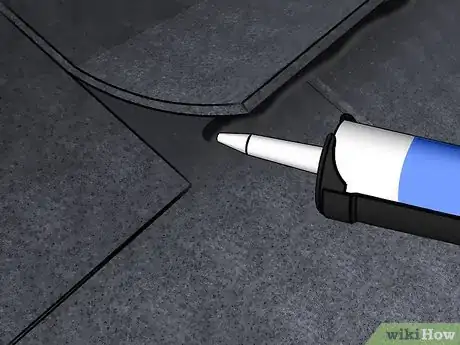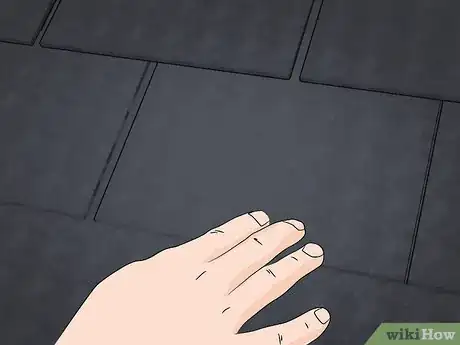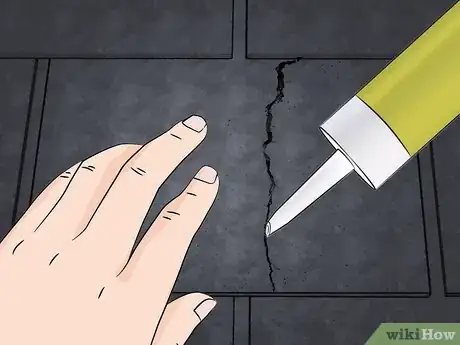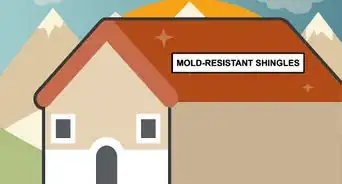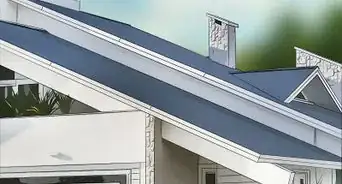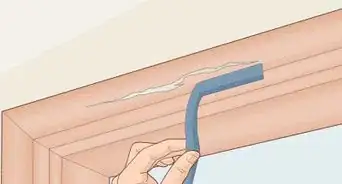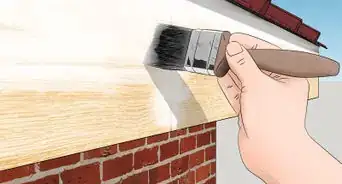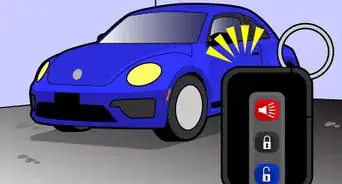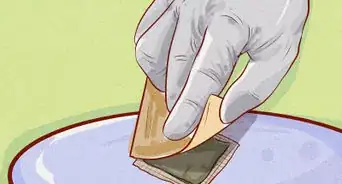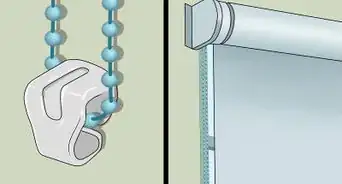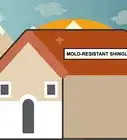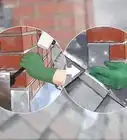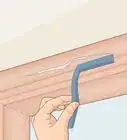This article was co-authored by David Bitan. David Bitan is a roofing professional, licensed contractor, and the owner and founder of Bumble Roofing based in Southern California. With over 12 years of construction industry experience, David specializes in restoring, repairing, and maintaining residential, commercial, and industrial roofs. With over 60 years of combined experience, Bumble Roofing provides easy, friendly services to structures including residential, commercial, industrial, multi-family, and government buildings along with hospitals, hotels, and churches.
wikiHow marks an article as reader-approved once it receives enough positive feedback. In this case, 90% of readers who voted found the article helpful, earning it our reader-approved status.
This article has been viewed 359,216 times.
Damaged shingles can seriously cut into the life of a roof. To keep your house secure, it's important to regularly evaluate and replace damaged shingles to make sure your home is safe and dry.[1] You can learn to properly evaluate, remove, and replace damaged shingles efficiently.
Steps
Removing Damaged Shingles
-
1Use the proper safety precautions. Any time you're getting up on the roof you need to practice roof safety. Wear protective eyewear, heavy-duty gloves, and gripping boots appropriate for walking on the roof. Preferably, you'll also install roof jacks to have something to stand on, and harnesses to protect yourself. Never do roof work alone.[2]
- How you access the roof will depend upon the roof itself and the location of the damage. Always use a secure, sturdy ladder when you're climbing up on the roof, and have a helper to secure it at the base. When walking on the roof, always walk slowly and secure your footing before taking another step.
- If you're just trying to assess the damage and replace a few damaged shingles, it might seem like overkill to install roof jacks and harnesses, but depending on the complexity and the height of your roof, it might be the safest option. Roof work isn't something to rush.[3]
-
2Assess the damage. Find the damaged area of shingles and determine how many new shingles you'll need and the extent of the damage underneath. Look at the corners on the shingles surrounding the damage. Are they curled and pulled up from the roof?
- Check the damaged area for damage to the moisture barrier or flashing, and check the damaged area for signs of seepage. If the surrounding shingles aren't doing the work of keeping moisture out, you'll need to replace everything in the square around the damaged area.[4]
- In some cases, it might be better to remove all the shingles from a roof in urgent need of repairs and re-roof the house instead. If the shingles in the area surrounding the damage are old, brittle, and dry, it’s probably not worth taking the care to re-secure them to the roof.
- Cracked or split shingles may be repaired without removing them, provided they're still in good condition. You can learn more about securing the shingles in the following section.
Advertisement -
3Remove shingles in cool weather. Asphalt and asphalt sealant will heat up in hot weather, making it moldable and much more difficult to remove. It's a lot easier to remove shingles that are cooled down and slightly more brittle than the moldable, so do the work of removing them first thing in the morning, before the sun has beaten down upon them considerably.
- Wet shingles to cool them down before removal, if you must work in the heat. Wetting them down with a small amount of water will help them to tighten and firm up, making them much easier to remove, if necessary.
-
4Loosen the adhesive under the tabs two rows above the damage. Removing all the shingles on the roof is usually done with a large hayfork , or rake-sized scraper used for removing shingles. Since you're only removing a portion of shingles, though, it's usually better to use a smaller tool. A pry bar, crow-bar, or the claw of a hammer works perfectly at getting under and carefully prying up shingles, separating the adhesive and revealing the nails of the shingles underneath.
- A good rule of thumb is to remove at least five tabs in the second row above the damaged "3-tab" shingle. Pull up enough shingles to reveal the nails of all the damaged shingles that need removed below.
- The end seams should be lined-up about a foot off to one side of the damaged one. In other words, you'll want to make sure that you pull off shingles in a radius around the damaged portion, to make sure you get everything.
-
5Loosen the exposed nails. Slide your flat pry-bar under the shingles around the damaged portion. Work around the nail, pulling it up. Carefully lift each surrounding tab about 45 to 60 degrees. Go very slowly, but pry firmly, and try not to crack or break them. If the surrounding shingles are in good shape, you can reattach them when you're finished replacing the damaged shingles, saving you money and effort.[5]
-
6Continue loosening the adhesive and nails closer to the damaged shingles. Work your way progressively closer to the damage. Lift the tabs in the first row above the damaged shingle and withdraw the loosened nails from that shingle with the pry-bar by using the same process.
-
7Loosen and remove the damaged shingles. Loosen the adhesive underneath the tabs of the damaged shingle, then pull them free and discard. If the shingles are severely damaged, don't try to salvage them. Just remove them and replace them with new shingles of a similar style to the rest of the shingles on the roof.
- Continue removing the damaged shingles until you've cleared out the shingles that will need replacing. It'll be easier to remove everything before you get started replacing them.
Replacing Shingles
-
1Get the necessary replacement materials. To replace shingles, you'll obviously need shingles to replace the ones you remove and the materials necessary to secure. Most shingles that are in need of replacement are three-tab asphalt shingles. If your roof involves some other variety of shingles, you'll need to match your new shingles to the old. To complete the job properly, you'll need:
- Replacement shingles. Buy more than you'll need at the home repair store. You should be able to count up how many damaged shingles will need replacement and buy accordingly. It's good to have replacements on hand.
- Shingle cement or adhesive. Some shingles come with adhesive strips pre-installed,[6] making this unnecessary. If you buy unbacked shingles, though, you might need to purchase additional adhesive to secure them to the roof before nailing them. It's a good idea to buy it to secure other loose shingles anyway.
- Roofing nails. Most three-tab shingles will be pre-cut with guide holes that will make the installation process very simple. To secure them, you'll need roofing nails, which are heavy-duty, and about two or three inches long.
-
2Install the new shingle. Place a new shingle in the same position as the shingle you removed. If the shingles are backed with an adhesive strip, remove the covering and push them into place, then nail them to secure them. Most shingles have pre-cut holes for nails, usually three per shingle. Follow the directions of the shingles that you purchase, or use the other shingles on the roof as a guide.
-
3Reseal under edges of all three shingles. Lift each tab slightly on the shingles as you install them, and apply a 1" (2.5 cm) diameter spot of shingle cement under each tab. Press tabs down into the cement firmly and secures the shingle into place. Continue installing shingles and securing them with adhesive accordingly, until you've installed all the damaged shingles along the row.
- After you've finished the damage portion, you can start working your way back up the roof, retailing the loose shingles into place, as long as they're in good shape, and using the adhesive to secure them back onto the roof.
-
4Secure other loose shingles while you’re at it. While you're up there working, it's a good idea to keep an eye out for other areas that look like they may become problematic in the future. Keep an eye out for curled or weathered-looking shingles that might allow water to seep in underneath. Using your adhesive, lift the tabs gently and re-secure them.
- Shingles become damaged when water gets in underneath and starts rotting from beneath. If you rescuer loose or weathered shingles on a regular basis, you'll get a considerable amount more life out of them. Regular touch-ups can extend the life of a roof immensely.
-
5Fix cracked or split shingles instead of replacing them. If shingles become cracked or otherwise split, because of falling branches or other types of damage, consider using adhesive to repair them as best you can, instead of removing them completely. Line the crack with a liberal amount of adhesive and stick it back together to repair it. Hold it in place for several seconds and let it seal.</ref>
- Shingles will always need to remove when they're brittle, curled, and difficult to pin back down. If the shingle is crumbling as you work on it, that's a sign that the shingle, most of the shingles in that area, and possibly the rest of the roof may need to be redone.[7]
How Do You Locate Roof Damage?
Expert Q&A
-
QuestionHow can I prevent shingles from becoming damaged?
 David BitanDavid Bitan is a roofing professional, licensed contractor, and the owner and founder of Bumble Roofing based in Southern California. With over 12 years of construction industry experience, David specializes in restoring, repairing, and maintaining residential, commercial, and industrial roofs. With over 60 years of combined experience, Bumble Roofing provides easy, friendly services to structures including residential, commercial, industrial, multi-family, and government buildings along with hospitals, hotels, and churches.
David BitanDavid Bitan is a roofing professional, licensed contractor, and the owner and founder of Bumble Roofing based in Southern California. With over 12 years of construction industry experience, David specializes in restoring, repairing, and maintaining residential, commercial, and industrial roofs. With over 60 years of combined experience, Bumble Roofing provides easy, friendly services to structures including residential, commercial, industrial, multi-family, and government buildings along with hospitals, hotels, and churches.
Roofing Contractor & Maintenance Professional Make sure your gutters are cleaned out every couple of months. Having gutters that are clogged causes water and debris to pool in certain areas of your roof, which can lead to damage.
Make sure your gutters are cleaned out every couple of months. Having gutters that are clogged causes water and debris to pool in certain areas of your roof, which can lead to damage. -
QuestionCan I reuse shingles that have been carefully removed?
 Community AnswerIt is difficult to re-install old used shingles once they are removed. They are usually damaged and the nails have pulled through them. If nothing else, you have to use NP1 or equivalent sealant to re-seal the tabs since the sealant will no longer be any good on used shingles. You have to re-seal the tabs so the wind does not blow them up and cause further damage.
Community AnswerIt is difficult to re-install old used shingles once they are removed. They are usually damaged and the nails have pulled through them. If nothing else, you have to use NP1 or equivalent sealant to re-seal the tabs since the sealant will no longer be any good on used shingles. You have to re-seal the tabs so the wind does not blow them up and cause further damage. -
QuestionCan I re-shingle a roof without taking off the old ones? And if all shingles are to be replaced, what else should be done when redoing a roof?
 Community AnswerYou can leave on the old shingles, but really shouldn't. Every layer of shingles adds weight, which your rafters must now hold up. It's code in most places to not have more than two layers of roofing materials. If you have to redo your roof, you should also inspect the soffit and gable flashing, eve troughs, and flashing around any chimney, plumbing vent, attic vent, etc and consider replacing those as well. Especially if they are the plastic type, as they may look okay but be decayed by the sun to the point of being brittle.
Community AnswerYou can leave on the old shingles, but really shouldn't. Every layer of shingles adds weight, which your rafters must now hold up. It's code in most places to not have more than two layers of roofing materials. If you have to redo your roof, you should also inspect the soffit and gable flashing, eve troughs, and flashing around any chimney, plumbing vent, attic vent, etc and consider replacing those as well. Especially if they are the plastic type, as they may look okay but be decayed by the sun to the point of being brittle.
Warnings
- In cold weather, avoid excessive bending of the shingles as it could cause cracking⧼thumbs_response⧽
- If you are unsure about anything, don't risk your well-being; please consult a roofing professional.⧼thumbs_response⧽
- In hot weather, cool shingles with a water hose to allow easy separation of the shingle tabs⧼thumbs_response⧽
References
- ↑ David Bitan. Roofing Contractor & Maintenance Professional. Expert Interview. 14 July 2020.
- ↑ https://www.gaf.com/en-us/for-homeowners/roofing-101/diy/learn-roofing-safety
- ↑ David Bitan. Roofing Contractor & Maintenance Professional. Expert Interview. 14 July 2020.
- ↑ http://www.gaf.com/Roofing/Residential/DIY/Fixes_And_Repairs
- ↑ https://www.thisoldhouse.com/ideas/fixing-damaged-roof-shingles
- ↑ https://www.nachi.org/asphalt-comp-shingles-part5-59.htm
- ↑ http://www.thisoldhouse.com/toh/article/0,,219567-3,00.html
About This Article
In order to replace damaged roof shingles, you need to remove the damaged shingle, install the new one, and seal the edges. Use the claw of a hammer to loosen the adhesive under the tabs 2 rows above the damaged shingles, and then loosen any exposed nails with the claw. Work your way down to the damaged shingles, loosening adhesive and nails so you can pull the damaged shingles free. After that, place the new shingle in the same position and use shingle cement to reseal the edges of all of the shingles. Hammer in any exposed nails that you loosened so the shingles are secure. To learn how to fix cracked or split shingles instead of replacing them, keep reading!

